
Navy Victoria
Network
Proudly supported by the Melbourne Naval Committee
Commodore Dacre Henry Deudraeth Smyth AO
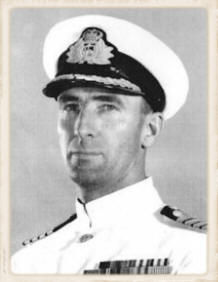 Dacre
Henry Deudraeth Smyth was born in London on 5 May 1923, the son of
British military hero
General Sir Nevill Smyth, who won a Victoria
Cross under Lord Kitchener at the Battle of Omdurman in Sudan in
1898 and was considered unlucky not to have been awarded a second VC
during the Boer War. He went on to command the First Australian
Brigade at Gallipoli and in 1916, the Second Australian Division. His links to Australians led him to emigrate with his family in 1925
and settle at the merino sheep farm Kongbool, near Balmoral in
Victoria's Western District. Dacre hailed from a distinguished
family, with his father's first cousin, Lord Robert Stephen Smyth
Baden-Powell, a hero of the 217-day siege of Mafeking in the Second
Boer War from October 1899, and later founder the Boy Scout
movement, in which Smyth was to have a leadership role in Victoria.
Dacre
Henry Deudraeth Smyth was born in London on 5 May 1923, the son of
British military hero
General Sir Nevill Smyth, who won a Victoria
Cross under Lord Kitchener at the Battle of Omdurman in Sudan in
1898 and was considered unlucky not to have been awarded a second VC
during the Boer War. He went on to command the First Australian
Brigade at Gallipoli and in 1916, the Second Australian Division. His links to Australians led him to emigrate with his family in 1925
and settle at the merino sheep farm Kongbool, near Balmoral in
Victoria's Western District. Dacre hailed from a distinguished
family, with his father's first cousin, Lord Robert Stephen Smyth
Baden-Powell, a hero of the 217-day siege of Mafeking in the Second
Boer War from October 1899, and later founder the Boy Scout
movement, in which Smyth was to have a leadership role in Victoria.
Dacre Smyth joined the RAN in September 1940 as a Special Entry
Cadet Midshipman and after six months training at the Royal
Australian Naval College (RANC), was posted as a Midshipman to the
heavy cruiser HMAS Australia, joining in Sydney in May 1941. Australia was at that time attached to the Royal Navy (RN) operating
in the East Indies Station where the ship was mainly involved in
convoy escort duties in the Indian Ocean. She returned to Sydney in
December 1941 when Smyth was promoted Sub Lieutenant. Australia
subsequently became Flagship of the Australian Squadron and was
Flagship of the Support Group during the Battle of the Coral Sea
when, in May 1942, Smyth celebrated his 19th birthday.
One of his abiding recollections of the battle, as his ship was
avoiding torpedoes and bombs dropped from Japanese aircraft,
illustrates some of the black humour typical of Australian
servicemen under fire. He was in the cramped transmitting room just
below the waterline passing instructions to the 8-inch gun turrets
on the ship when he noticed a wooden mallet swinging by the exit
ladder. He asked his superior what the mallet was for, only to be
told:
When we're sunk, the compartment above will get flooded, so nobody will be able to open the hatch and let us out. We will have enough air in here to survive for a couple of hours while we're sitting on the bottom. In that time some of you might go around the bend. That mallet is for me to knock out anybody who cracks up.
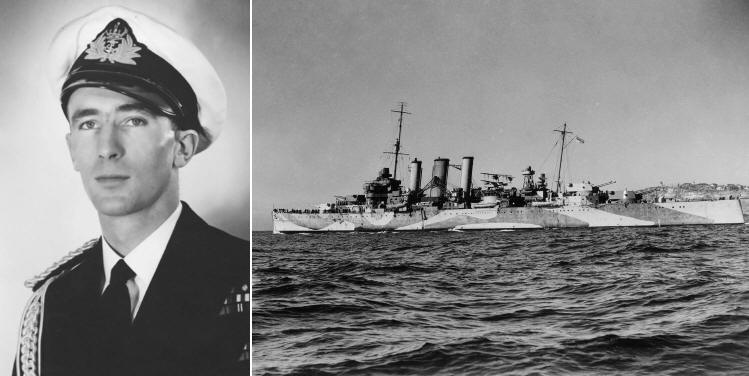
Dacre Smyth's
first RAN sea posting was to the flagship, HMAS Australia (II).
Smyth would see action while serving in Australia during the Battle
of the Coral Sea in May 1942, aged 19.
In July 1942 he travelled to England to undertake the usual
courses in navigation, surface gunnery, torpedo gunnery and
signalling for young officers in the RN and RAN. Attaining First
Class passes in these courses, and unable to get an immediate
passage back to Australia he served for a short time in Motor
Torpedo Boats based at Lowestoft, Suffolk on the North Sea. Promoted
Lieutenant, he then re-joined Australia to complete his training. During this period the ship was involved in bombarding enemy held
islands in the South West Pacific, prior to allied assaults. He
gained his Bridge Watchkeeping Certificate in October 1943.
In November 1943, Dacre was posted for exchange service in the RN
joining the World War I-era cruiser HMS Danae as gunnery control
officer in March 1944. He was just 21 when he took part in the D-Day
landings at Normandy, France. On 6 June 1944, Danae operated off
Sword Beach bombarding the German batteries near the seaside town of
Ouistreham, on Sword's eastern extremity. When the ship had run out
of ammunition it was designated as a ‘mother ship’ for small craft
in the Sword area.
Smyth’s Commanding Officer, Captain John RS Haines RN, ordered him
to get a boat and take his gun crews ashore to see if they could
help the army. He added that if he got anywhere near a village or a
shop, to purchase a camembert cheese. Smyth asked “What?” and was
advised that it was a French cheese made in Normandy. When he
returned onboard that night, he told his Captain that he had the
cheese. Haines then called a motor torpedo boat alongside, gave the
Coxswain the camembert and it was despatched to Portsmouth at 50
knots. Haines later explained that he had attended the Royal Naval
College, Osbourne with King George VI (then Prince Albert, Duke of
York) and that they were friends. He had called on the King at
Buckingham Palace before sailing and was asked to get a camembert
cheese whilst off Normandy. It was the King’s favourite cheese and
he hadn’t tasted one for five years. Smyth’s captain told him that
the cheese was on its way back to Portsmouth where a Buckingham
Palace car would wait to take it to the Palace for the King’s
breakfast. Some three weeks later Captain Haines was made a
Commander of the Order of the British Empire for his work at
Normandy.
Smyth served in Danae until 3 November 1944 and whilst awaiting
passage, flew several missions in the back seat of RAAF 455 Squadron
Beaufighters as they attacked German shipping along the Norwegian
and Dutch coasts.
In late November 1944, Smyth travelled to Ceylon to join the
destroyer HMAS Norman which was operating with the British East
Indies Fleet and, from April 1945, with the British Pacific Fleet
screening RN carriers. Norman was some 85 nm east of Japan on August
6, 1945, when another officer called him on deck to see a
“spectacular sunset”. Smyth immediately wrote a poem, the second
verse of which recorded:
No cloud, I say, but yet the sun did light
On towering columns all unreal yet huge
Which waved and shuddered in grotesque delight
In myriad hues of ghostly subterfuge.
Unknowingly, he was describing the aftermath of the dropping of an atomic bomb on Hiroshima. Smyth later recalled:
It had a really shimmery effect, which was the dust in the distance from the atom bomb. We had no idea until the next morning; we'd never heard of an atom bomb
In December 1945 Smyth was appointed Executive Officer of the
River Class frigate HMAS Murchison upon the ship's commissioning. Murchison became part of the British Commonwealth Occupation Force
in Japan before returning to Australia in mid-1946. In March 1947
Smyth was given his first sea going command, the corvette HMAS
Latrobe, operating out of Flinders Naval Depot Victoria, taking
recruits and Cadet Midshipmen on training cruises. Following his
time in Latrobe, Smyth was selected as the Aide-de-camp to the
Governor-General, Sir William McKell in April 1948.
After a year in that role, Smyth felt he had better return to sea to
be brought back down to earth as he had begun telling Admirals and
Ministers of State what to do. In March 1949 he joined HMAS Bataan
as her Executive Officer and again served with the British
Commonwealth Occupation Force in Japan. In late June 1950, Bataan
was en route to Japan for a fifth tour when the Korean War started.
From early July 1950 until 29 May 1951, the destroyer operated off
Korea; patrolling and blockading, escorting aircraft carriers, and
bombarding shore targets.
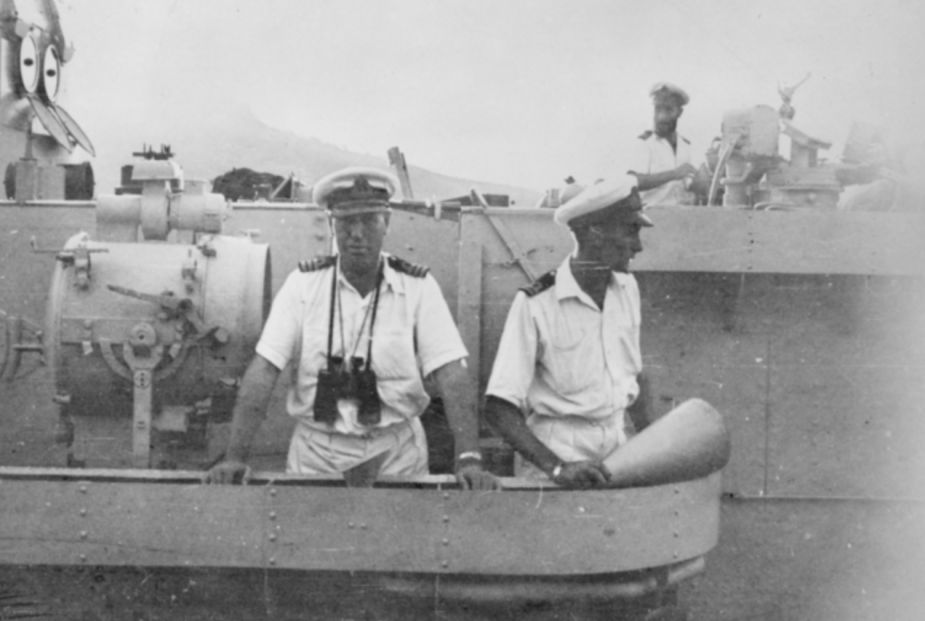
Commander William Marks, DSC, RAN (left),
Lieutenant Dacre Smyth RAN (right) and Lieutenant Patrick Burnett
RAN (in background on the compass platform) standing on the wings of
the bridge of HMAS Bataan as the ship slips from alongside a depot
repair ship in the port of Kure, Japan, to take part in the US-led
landing at Inchon.
(AWM collection)
On 4 December 1950, HMAS Bataan, commanded by Commander William BM Marks, DSC, RAN, was ordered to proceed to the Taedong River estuary and join her sister ship HMAS Warramunga, three Canadian destroyers HMC Ships Cayuga, Athabaskan and Sioux and USS Forrest Royal. Captain Jeffrey V Brock DSC, RCN, in Cayuga was in command as they were ordered to assist in the evacuation of troops and wounded waiting at Chinampo some forty miles away. Captain Brock decided upon night sailing, and the ships moved slowly in line ahead through icy darkness and falling snow; through the minefields of swept channels. He had warned the passage might be “fairly tricky” Smyth later recalled:
Fairly tricky? That’s an understatement if ever I heard one. A winding channel a bare cable’s width through minefields, rocks and reefs, with the land far beyond accurate radar range, no lights, a fifty-year old chart, and it is only “fairly tricky” well, well!
In February 1951, Smyth was appointed to the RANC
to supervise the new scheme of Intermediate Entry Cadet Midshipmen
and shortly after, in April, was promoted Lieutenant Commander. Smyth married Jennifer Haggard in 1952, the granddaughter of
Geoffrey Syme, who ran The Age after his father, David, the
newspaper's founder. Her father, Commander Geoffrey AG Haggard DSC,
RAN, was a member of the Australian submarine AE2 which passed
through the Dardanelles on the original Anzac Day, and was later
sunk. Dacre and Jennifer would go on to have four daughters and a
son.
Smyth remained at RANC until October 1953 when he was appointed
Commanding Officer of River Class frigate HMAS Hawkesbury.
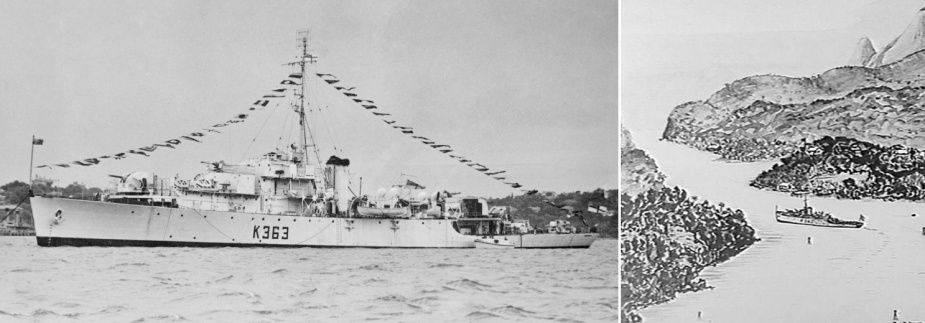
Smyth's great skill as an artist was being
honed while serving in the RAN, as can be seen in his sketch of the
frigate HMAS Hawkesbury in Buka Passage, Solomon Islands.
(AWM collection)
For the next 14 months Hawkesbury undertook
routine patrols and training exercises off the Australian and New
Guinea coasts including policing Japanese pearling fleet operations.
She also completed two patrols of Australian waters in the
South-West Pacific area. Hawkesbury's tour of duty on the northern
patrol ended in December 1954 when she returned to Sydney and paid
off on 14 February 1955.
After a year as Staff Officer (Operations) to the Flag Officer in
Charge Eastern Australia Area, Smyth was promoted Acting Commander
and sent to Navy Office as the Director of Tactics and Staff
Requirements in June 1956. He was confirmed in the rank of Commander
in December that year and remained on the naval staff until July
1958 when he attended the United States Armed Forces Staff Course in
Norfolk, Virginia, graduating in January 1959. This was followed by
two years exchange service in the RN where he served as Executive
Officer of the RN Air Station Sanderling near Glasgow, Scotland.
Returning to Australia in early 1961, he was posted to Navy Office
as the Deputy Director of Manning and Training, becoming the
Director in July 1962 as an Acting Captain. Smyth was confirmed as a
Captain in December 1963 and posted as Naval Officer in Charge
Jervis Bay and Commanding Officer HMAS Creswell (RANC) in January
1964. In November 1965 Smyth returned to the UK as the Australian
Naval Representative UK, in the Australian High Commission, London,
serving in the rank of Commodore.
Following two years abroad, Smyth returned to Australia in December
1967 and reverted to Captain to command the Tide Class Fleet Tanker,
HMAS Supply. During his period in command Supply participated in a
broad range of Commonwealth and SEATO exercises during which time
she visited numerous South East Asian ports. She also routinely
refuelled HMAS Sydney and her escorts deploying to or returning from
Vietnam. In 1969, in a first for an RAN replenishment ship, Supply
was awarded the prestigious Duke of Gloucester’s Cup being deemed
the RAN ship displaying the highest level of overall proficiency in
the fleet.
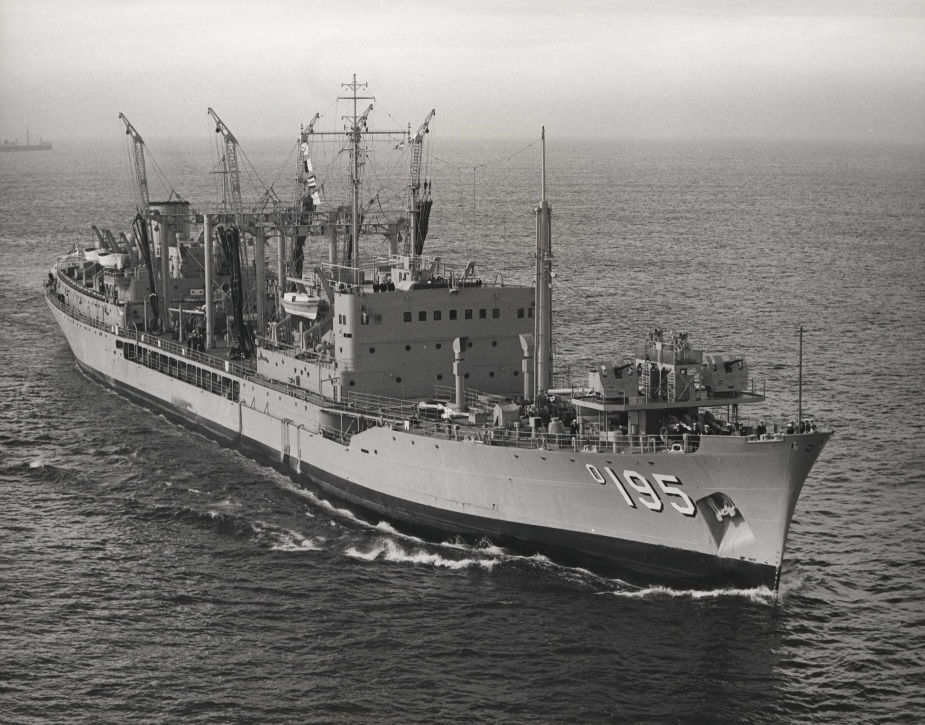
Smyth served as Commanding Officer of the
replenishment ship HMAS Supply, with the ship being awarded the
prestigious Duke of Gloucester's Cup in 1969.
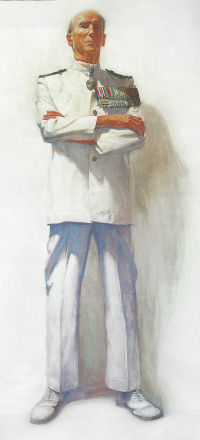
In August 1970, Smyth was posted to the Personnel Division in Navy Office leading a team to review the the RAN’s sailor structure, reporting in early 1971. In April 1971 he was promoted Commodore and posted as Naval Officer in Charge, Victoria and Commanding Officer of HMAS Cerberus at Flinders Naval Depot, the RAN’s major training establishment. He remained there until January 1974 when he was posted Director General Naval Personal Services in Navy Office before returning as Naval Officer in Charge Victoria in November 1975. He remained in this position until his retirement in May 1978.
Painting was a keen hobby during his time in the RAN, and when he
retired, Smyth transformed himself into a compelling artist, as a
painter, maker of stained glass windows and author. He sold more
than 2800 paintings and self-published 14 books illustrated with his
paintings and verse.
He served as Deputy Chairman of the
Trustees of Melbourne’s Shrine of Remembrance and was a Life
Governor of the Shrine.
In 1977, he was made an Officer of the Order of Australia.
In 1994,
on the 50th anniversary of D-Day, he was made an officer in the
French Order National du Merite for his service at Sword Beach and
in 2004 he was granted the Legion d' Honneur from former French
president Jacques Chirac at the 60th anniversary of D-Day.
He remained attracted to the sea. In 2005, he took Jenny on a cruise around the Marquesas Islands in the Pacific, not on a luxury liner like other octogenarians, but in a cargo ship that "catered for a few crazy passengers", according to their son, Os. "They regularly hopped on and off whaleboats in choppy seas, onto slippery stone piers and were lucky to return with their hips intact."
Commodore Dacre Smyth AO, RAN (Ret’d), passed away on 3rd December 2008 at his Toorak home aged 85. He is survived by his wife, Jenny, daughters Benita Buchanan, Bronwen Atteridge and Bambi Smyth, son Osmond, and 11 grandchildren. Another daughter, Belinda, predeceased him.
Australian at War Film Archive - Dacre Smyth
Pictures in my life - Dacre Smyth
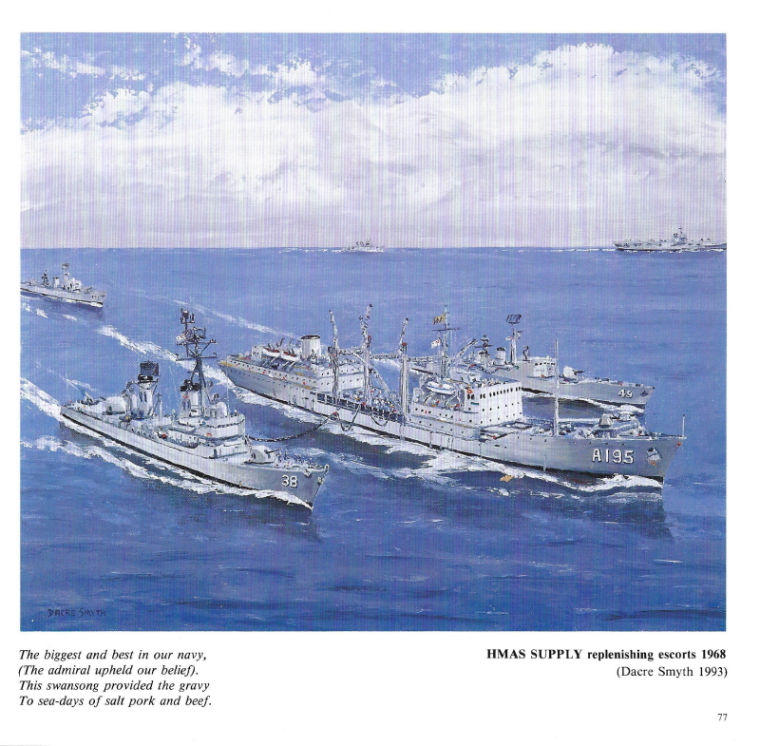
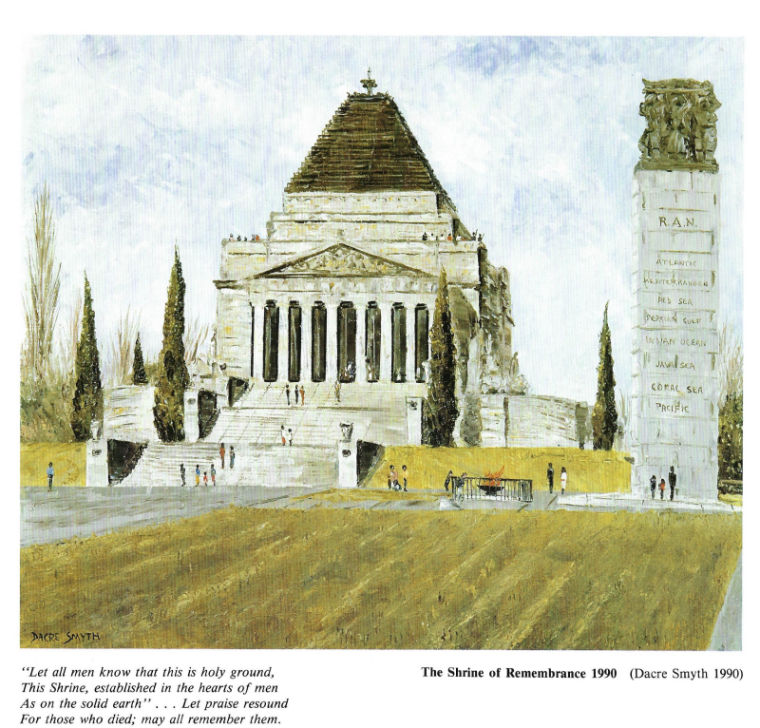
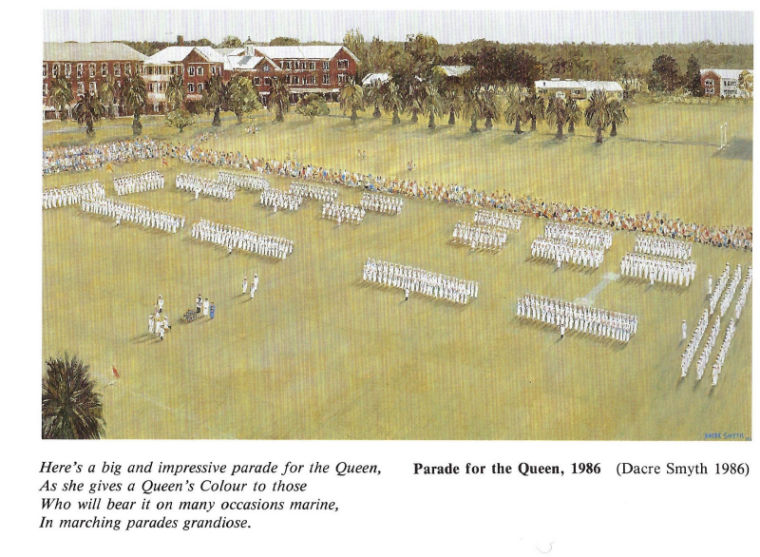
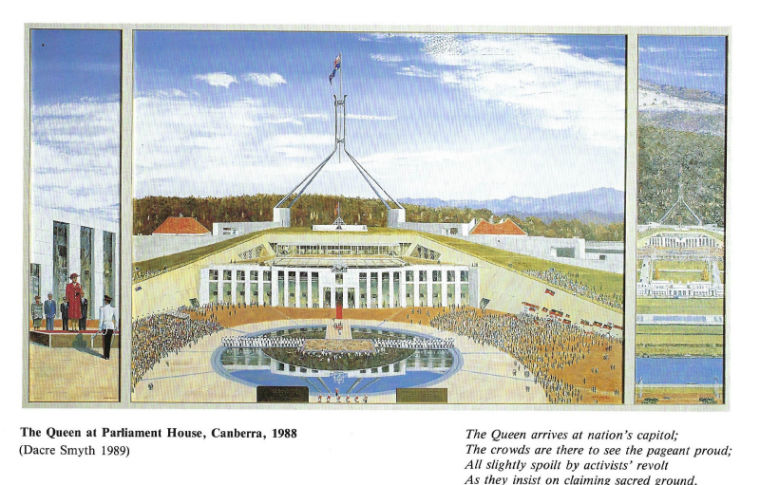
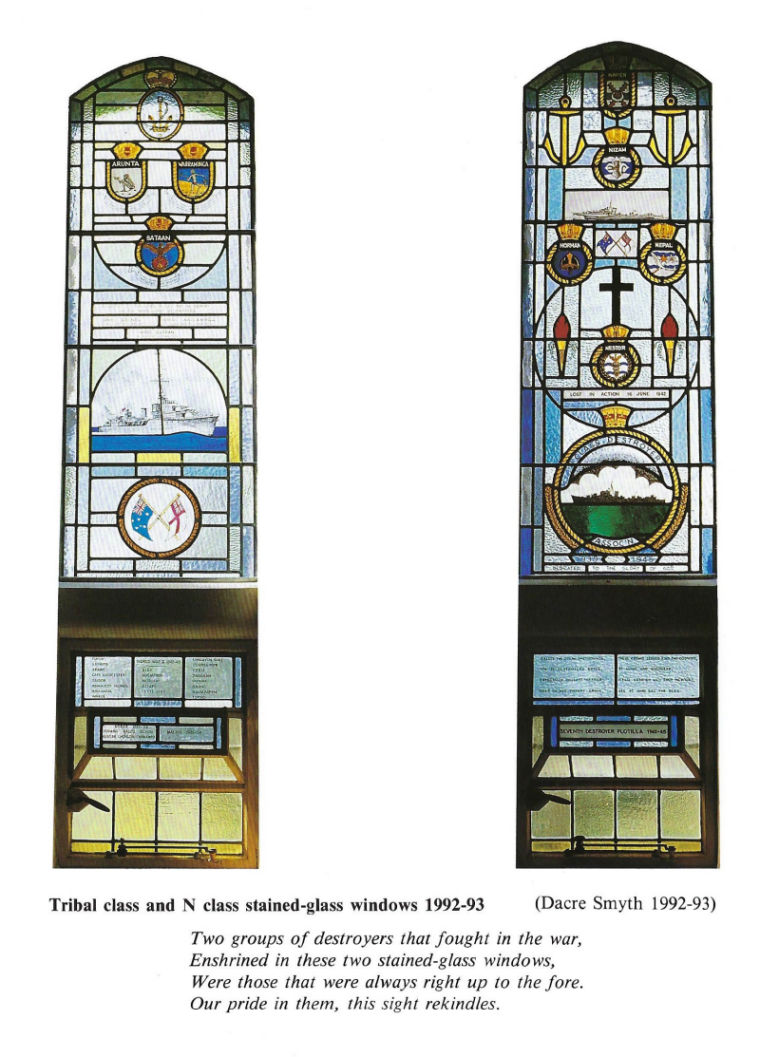
Sources:
Royal Australian Navy Biographies - by Commodore Hector
Donohue AM RAN (Ret’d)
Pictures in my life:
Dacre Smyth
1923 to 2008 - Naval Commodore and Artist
UNSW Canberra -
Australians at War Film Archive